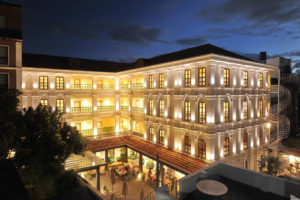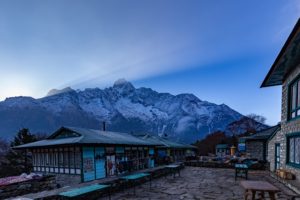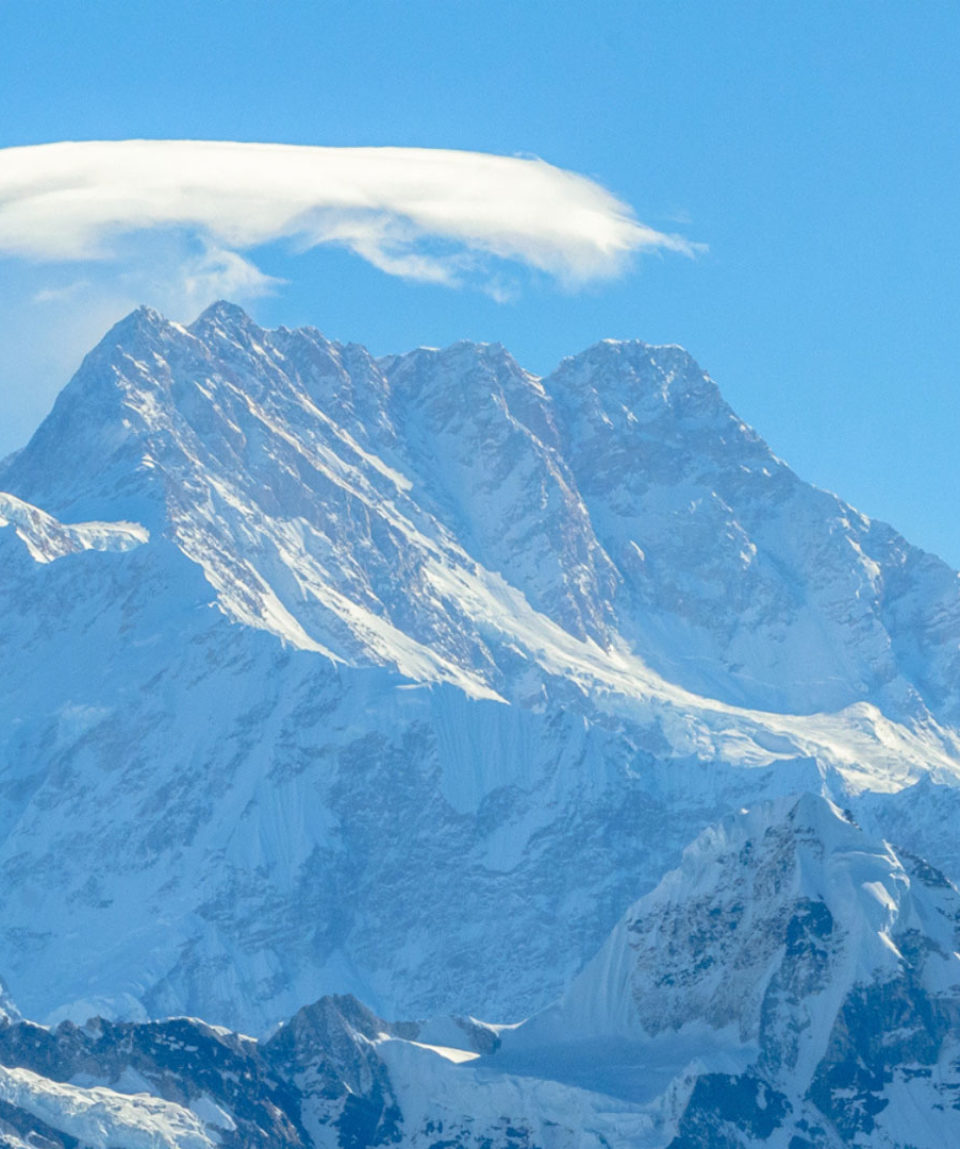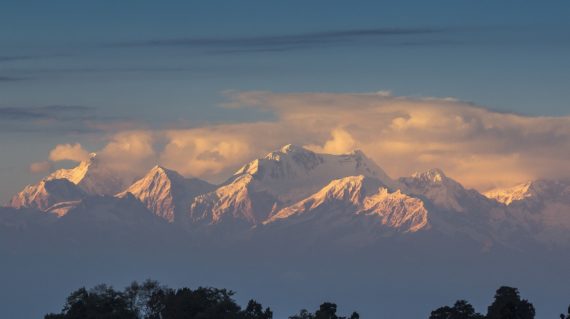
Ultimate Kanchanjunga Trekking
fromOne of the best treks in the Nepal Himalayas is the Kanchenjunga trip. Following Nepal’s hilly border with India and Tibet, the hiking route.
At 8,586 meters, Mount Kanchenjunga is the third-highest mountain in the world. British mountaineers Joe Brown and George Band made the first ascent of the summit in 1955. The second ascent of the northeast ridge from Sikkim on the Indian side was made in 1977 by a team from the Indian Army.
To reach the Makalu region for this trek, we go over a lonely portion of The Great Himalaya Trail. Kanchenjunga, the third-highest mountain in the world at 8,586 meters, is visited by trekkers on the Kanchenjunga Circuit in both the north and south base camps. A decent degree of fitness and previous trekking experience is preferred for this trek because it takes place in a remote location. Despite its isolation, hikers can visit Ramtang and Oktang Monasteries and learn about local culture.
Along the way, the scenery is varied and includes rivers, waterfalls, verdant meadows, birch, and pine forests, the Yalung Glacier, and of course, the gorgeous mountains that line the road.
Rhododendrons and the alpine region are among the vegetation types, in addition to the subtropical jungle. The stealthy snow leopards stalk higher elevations while red pandas reside in the forests. You can see ethnic Tibetan Buddhist tribes like the Rai and Limbu living in ancient villages.
Our cooks will prepare your meals while you sleep in tents on your trekking expedition. The actual Kanchenjunga mountain is located on Nepal’s extreme eastern side, close to the border with Sikkim, a tiny Himalayan state in India’s northeast. Kanchenjunga was believed to be the tallest peak in the world until the middle of the 19th century.
Trekkers couldn’t enter this area until the middle of 1980. A unique hiking permit is necessary now because the area is protected by the Kanchenjunga Conservation Area. Due to these limitations, the area’s stunning and distinctive flora and animals are preserved in pristine condition today.
Regarding the mountains themselves, in addition to the Kanchenjunga peak, four additional peaks are higher than 8,000 meters, with Kanchenjunga West, also known as Yalung Kang, being the most significant (8,505m). Twenty peaks higher than 7,000 meters may also be found in this region, the tallest of which are Kambachen (7,903 meters), Janu (7,710 meters), Jongsong (7,483 meters), Kabru (7,353 meters), Tent Peak (7,365 meters), and the Twins (7,350m).
There are also many peaks higher than 6,000 meters. Five significant glacial systems can be found within this remarkable collection of peaks. Of these, the Kanchenjunga and Yalung glaciers drain into Nepal’s potent Tamor River, while the Zumu, Talung, and Rathong glaciers flow into Sikkim to the west. This just serves to further emphasize how amazing Kanchenjunga hiking is, allowing hikers to enter the lonely, less-travelled slopes and valleys of the Himalayas.
-
Reviews 0 Reviews0/5
-
Vacation Style Holiday Type
-
Activity Level Ultimate
-
Group Size Small Group
Trekking Highlights:
- Explore the less traversed Eastern mountainous regions of Nepal, and find yourself dipped in endless surprises
- Walk past magnificent glacial lakes in the region
- Stay in nature amid the diverse flora and fauna
- Meditate in Ramtang and Oktang Monasteries after your tiring walks
- Enjoy Camping on the lap of the giant peaks
Why Trek with Us?
Quality: For us, quality includes both luxury and a feeling of community. We warrant the following link. The Kanchenjunga Circuit Journey has been planned so that we may create memories with the locals and ourselves in addition to hiking the trek. We’ll socialize, take photos, eat together, and settle in.
The tales of the locals, the sincerity of the monks, and priests at the monasteries and temples, and the innocence of the children playing in the chilly streets will lift our spirits more than the trekking we’ll be doing on our hike.
Giving back to the community: The Nepalese communities that contribute directly or indirectly to the trekking sector in this nation blessed with exceptional mountains gave birth to Elite Explorer. We are explorers, not simply trekkers, and we want to contribute in some way to the towns, villages, and routes we pass on our adventure through the Kanchenjunga Circuit Trek, even if it’s just a small amount.
We will assist in cleaning the area around the high-traffic villages that fall on our trail, and provide some first aid kits to the local clinics, schoolchildren there will receive stationery and books, and villagers along the route will receive meals.
Additionally, we will document the unseen stories about the struggles and the lifestyle in the area that we would be traveling to.
- Pick up and transfer to the booked accommodation by Elite Explorer representative from Tribhuwan International Airport Kathmandu. (please look for your full name card outside the arrival hall, +977 985 115 5251 arrival assistance WhatsApp call or message)
- Twin-sharing double bedroom accommodation with buffet breakfast in Kathmandu
- Guided know your surrounding tour in Kathmandu by our expert guide.
- Kathmandu Bhadrapur 30 minutes domestic flight.
- Bhadarapur-Illam drive by private vehicle.
- Guided trek by our expert and experienced English-speaking trekking guide. (Language guide can arrange based on your preference)
- A porter to help carry our bags (trekking bags must not exceed 20 kg,2 pax combined)
- Locally available breakfast, lunch, and dinner including tea or coffee.
- Basic Mountain Lodges (famously known as tea houses) for accommodation.
- Guide Porter salary remunerations and insurance
- Trekkers Information Management System (TIMS) card
- Necessary documentation and restricted zone trekking permit from the Department of Tourism and Immigration Office.
- First aid kit including oxygen meter.
- Khamdime Bhadrapur drive by the locally available jeep.
- Bhadrapur- Kathmandu domestic flight.
- Government tax
- Airport transfer upon completion of the program
- Client personal expenses and bar bill including soft drinks
- Natural Calamities beyond our control and expenses incurred in such rescue services.
- Travel/Medical Insurance
- Day 01 Arrival in Kathmandu
- Day 02 Trekking preparation and Kathmandu exploration
- Day 03 Kathmandu Bhadrapur flight, drive to Ilam 5 to 6 hours
- Day 04 Ilam to Taplejung (Drive), 4 to 5 hours
- Day 05 Taplejung to Chirwa, 5 to 6 hours
- Day 06 Chirwa to Lelep, 6 to 7 hours
- Day 07 Lelep to Amjilosa, 5 hours
- Day 08 Amjilosa to Gyabla, 3 to 4 hours
- Day 09 Gyabla to Ghunsa, 3 to 4 hours
- Day 10 Acclimatization day
- Day 11 Ghunsa to Kambachen, 3 to 4 hours
- Day 12 Acclimatization Day
- Day 13 Kambachen to Lhonak, 3 to 4 hours
- Day 14 Day Trip to Kanchenjunga North Base Camp, 8 hours
- Day 15 Lhonak to Ghunsa, 7 hours
- Day 16 Ghunsa to Sele Le, 5 hours
- Day 17 Sele Le to Cheram, 7 to 8 hours
- Day 18 Day Trip to Kanchenjunga South Base Camp, 6 hours
- Day 19 Cheram to Torongding, 4 hours
- Day 20 Torongding to Yamphuding, 7 to 8 hours
- Day 21 Yamphuding to Khebang, 4 hours
- Day 22 Khebang to Khamdime, 4 hours
- Day 23 Khamdime to Bhadrapur (Drive), 10 hours
- Day 24 Bhadrapur Kathmandu flight
- Day 25 Free day in Kathmandu
- Day 26 Departure


How many hours do we trek each day?
We will trek for six hours on average, but depending on the region you trek in, you might go for nine hours straight, including breaks for meals.
What transportation will it be to the trekking starting point?
Depending on the trekking region, either private transportation or air travel will be used.
Can I leave the things behind before heading for trekking?
Yes, we’ll tag your bag and keep it at your accommodation until you get back. Likewise, you should travel as lightly as possible when trekking.
Is it very cold in Kathmandu on my arrival?
There are four seasons and 300 days of sunshine in Nepal. As a result, Kathmandu’s lowest recorded temperature is -3 degrees Celsius, or 26.6 degrees Fahrenheit. However, while trekking, the temperature may drop to -13 degrees Fahrenheit or -25 degrees Celsius. For more details on what to pack and bring please contact your dedicated travel consultant or you can also contact us via E-mail.
Do I need to be extra careful of altitude sickness?
Our itineraries are made to give you plenty of time for acclimatization, reducing the likelihood that you will have altitude sickness. Every evening before or after dinner, our extremely knowledgeable guide will give us a briefing for the following day’s trekking, including instructions to prevent altitude sickness over 3500 meters. You must notify our guide right away if you have shortness of breath, headache, exhaustion, nausea, vomiting, a rapid heartbeat, or insomnia since altitude sickness can be fatal.
How many kg of bag pack am I allowed to carry?
The greatest option is usually to trek light. The best-recommended backpack weight is 10 kg for trekking bags and 5 kg for carry-on luggage because one must also include basics. (It also serves as the flight to Lukla’s weight restriction.)
Will there be a porter to carry my bag pack apart from the guide?
Yes, a porter will assist you in carrying the trekking backpack packs.
Can you tell me about the food in the mountains?
Most of the food is freshly prepared, but meats may have been stored for a while. Freshly prepared Daal and Bhat, a staple of traditional Nepali cuisine, are the finest.
How basic are tea houses, can I shower every day?
A basic bed, private or shared bathrooms, cold water in the absence of electricity or sunlight, charging the wifi battery, and the absence of a room heater. This is how simple tea houses seem. Further, during the cold winter, the water freezes in the pipe leaving no running water.As mentioned earlier, having a hot shower (or bucket full of hot water) is feasible in most tea houses, however, if unfavorable circumstances like an electricity cut-off occur, you may have to wait to take a hot shower.
Is there wifi or cellular signals in the mountains?
In the tea houses along the trails, there is wifi, however, the signal strength and speed may not be as advertised. On request, Team Elite Explorer will provide you with a local sim card for data subscription.
How about power, will there be charging points?
There will, in fact, be charging ports. Be considerate when charging your electronics as tea houses provide shelter for other hikers as well.
In case of medical issues, how will I get assistance?
Our guide will evaluate the case according to its seriousness, seek advice from the office as necessary, and then decide on the spot whether to transport the patient to the nearest medical facilities or call for help. When trekking in Nepal, kindly make sure to have comprehensive travel medical insurance.
Can 3 years and 80 plus age trek in the mountains?
Every age group can find the ideal trekking trails in Nepal. So every one of any age can hike in the mountains. When working with infants and the elderly, we take extra precautions both in the planning of the itineraries and on the ground.
Lastly, how fit should I be for trekking?
For the trek, you need to be both physically and mentally prepared. The outcome of your adventure entirely rests on you. We advise selecting the trekking routes based on your degree of fitness. There is little doubt that shorter routes are simpler than longer ones. A higher level of fitness will be needed for the longer treks. So, try to be in top physical shape.




